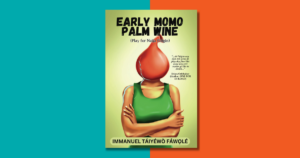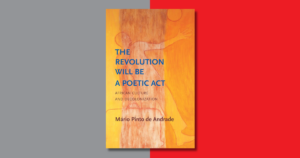
On a gray, spitting day in Venice last summer, I spent a morning strolling through the main exhibits of the Venice Biennale in the Arsenal. The building is tall and narrow, concrete and stolid, and like the cars of a train, you move from one enclosure to the next through a small vestibule. I turned one such corner and confronted a field of impaled skulls—of a kind. They were untouchable, behind an ankle-high rope, but you could circle them to an extent, see them in the round. Wooden branches, about as high and thick as broomsticks, were implanted in rough concrete blocks, heavy sacks nestled here and there at the base to keep them upright. And topping them were masks, or again, skulls—three-dimensional, chaotic conglomerations of long stringy hair, gnarled and carved wood, and clusters of metal nails like Congolese Nkondi.
The title of the exhibit was Smiling Disease. The placard told me that an American sculptor named Cameron Jamie designed this 2008 installation and commissioned an Austrian craftsman to make it. It riffs, the placard said, on the folk tradition of the Perchten, “an Alpine winter character associated with the Krampus,” a subject of Jamie’s earlier work, but it also “references the collections of tribal artefacts that were popular among Surrealist artists in the early twentieth century, thought to reflect contemporary ideas about the subconscious and the universal significance of dreams.”
The ethnographic impulse that spurred Surrealism to break free of the cage of “realism” in the early twentieth century dovetailed with a psychoanalytic tendency to relegate the subconscious to the realm of the “primitive.” Here is a characteristic conflation from Freud’s essay on the uncanny: “It seems as if each one of us has been through a phase of individual development corresponding to this animistic stage in primitive men . . . everything which now strikes us as ‘uncanny’ fulfills the condition of touching those residues of animistic mental activity within us.”
Smiling Disease invokes what the West continues to associate with tribalism—the primitive, the raw, the regressive, the nightmarish realm of the Id. It also directs us to consider the longstanding conditions of contact zones: the contested, racialized idea of appropriation; the distortions of what counts as “ethnic”; the relative imbalance of labor between the “artist” who commissions and the “craftsman” who makes. These are scarecrows and upended brooms—with their Western fairytale, Oz-like associations—but they are also impaled heads. Like those that Kurtz displays in Joseph Conrad’s Heart of Darkness, they reinforce the stereotypes of “tribal savagery”; work as a mirror for the white imperialist “gone native”; and stage a dramatic critique of imperialism and its savage dismemberments.
But it has always struck me that this appropriation/expropriation of “tribal artefacts”—African, Oceanic, and Native American masks and sculptures, to be specific—is too often relegated to a plagiaristic crime rather than seen as a profound aesthetic influence. What if Western art’s impulse was not to escape the real but to recognize modes of perception more attuned to the real? Duchamp’s and Picasso’s later experiments with Cubism didn’t just take from these artifacts a connotation of savagery or subconscious desires. They also took the use of imbricated and faceted planes to convey dimension, torsion, perspective, and movement—a sculptural version of stop-motion photography that non-Western cultures had long been practicing. This is why the faces in Smiling Disease—and they are clearly faces—ask not just to be looked at, but to be walked around.
All this history hangs in the air as you circumnavigate the field of skulls, yet there is a curiously quotidian feel to the installation. Some of the faces are playful, with splayed teeth and jutting tongues; others are bestial, the hair horse- or goat-like, yet still humanoid. They escape attributions of gender and—“ethnic” or “tribal” flavor notwithstanding—of race. Texture is more crucial to their skin than color. The nails hammered into some of them warn us away (monstrum) but also gesture toward injury. But it’s unclear, as in the work of Francis Bacon or Phoebe Boswell, whether it is injury or movement or a roiling centrifugal force that distorts them. Animal, vegetable, mineral. Figures, things, creatures, half-transformed.
The placard calls them “grotesque,” but I think Mikhail Bakhtin’s concept of the “carnivalesque” is more apt, in the sense of a masquerade that bursts with forms and media, that overturns binaries and hierarchies. The faces approach the sublime insofar as they are of the natural world and difficult to conceptualize; they approach the uncanny insofar as they are both homely and creepy. But they suit none of these aesthetic categories exactly—their hybridity has me reaching for a term that would capture the pleasures of monstrosity.
And in this, they remind me of Joseph Merrick, popularly known as “The Elephant Man.” This may seem outrageous. Joseph Merrick was a human being. But so was Cleopatra. What if we framed his face—with its multidimensional, multifaceted, multi-textural complexity—in the terms with which we frame hers—as a myth, an icon, a loaded figure, so to speak? The Elephant Man’s fame is often attributed to the profundity of his condition, by which I mean both how profoundly it changed his body and how its seeming contrast with his personality struck many as profound. But many other humans in history have embodied those profundities. Joseph Merrick is famous because he has long been an object of artistic representation.
The tradition of displaying The Elephant Man seems to have originated with Merrick himself. Having been cast out by his family after his mother’s death, then banned from his job as a hawker, Merrick entered the Leicester Union Workhouse at age 17. After a few miserable years and a surgery that mitigated some of his physical discomfort, Merrick contacted a well-known showman, Samuel Torr, to propose himself as an exhibit. Torr soon passed Merrick onto Tom Norman, who always insisted that Merrick expressed his preference for the life of the “freak show” over that of both the workhouse (“I don’t ever want to go back to that place,” Merrick said) and, though he ended up there, the London hospital: “I was stripped naked and felt like an animal in a cattle market.” Norman’s choice to display Merrick in fact followed the trend of Merrick’s own choice to be exhibited publicly.
There are at least five biographies of Merrick, several plays, and two films—David Lynch’s 1980 production, starring John Hurt, did much to bring Merrick’s story to public awareness. Merrick has become recognizable in his strangeness—indeed, it has become something of an honor to play him on film or on stage. Hurt was nominated for an Academy Award. Bradley Cooper was nominated for a Tony.
A couple of years ago, I went to see the London production of Bernard Pomerance’s play in which Cooper starred. I hadn’t read the play, or much about it, so I experienced firsthand the remarkable tromp d’oeil Pomerance insists upon. Scene 3, titled “Who Has Seen the Like of This?” opens with a spotlight on Cooper, dressed only in boxers, as the actor playing Treves stands beside him and describes Merrick’s body, a kind of perverse blazon. As succinctly described in the stage directions: “Treves lectures. Merrick contorts himself to approximate projected slides of the real Merrick.” Amazingly, this works. With no prostheses, only a slow, willful, visibly painful contortion of the actor’s body, The Elephant Man comes to life. We “see” him. Yet this vision is partial, or rather, hybrid, a live catachresis. Cooper maintains his posture for the rest of the play but he hovers inside or over Merrick, the actor’s physical beauty present in its distortion. This stages both the half-transformed quality of Merrick himself and the partial way we imagine when we experience art.
There’s also something of Brecht’s “alienation effect” to this—the idea that theater ought to prevent us from total immersion and emotional release by reminding us that the stage, the play, the actors are all part of an illusion. Rather than showing us props or stage lights, here we are continually made aware of the actor’s performance—and its inevitable inadequacy. It fails to be the bodily “failure” that many considered Merrick to be. This is because we know what Merrick looked like; his famously strange face becomes the “ideal” no actor can match. Pomerance’s Introductory Note insists:
Merrick’s face was so deformed he could not express any speech at all . . . Any attempt to reproduce his appearance and his speech naturalistically—if it were possible—would seem to me not only counterproductive, but, the more remarkably successful, the more distracting from the play. For how he appeared, let slide projections suffice.
I don’t think we even need slides anymore. So often has Merrick been depicted that, again like Cleopatra, his representation—our shared conjured picture of him—has eclipsed him. The recent discovery of a coin bearing Cleopatra’s profile attests that her reported beauty has overtaken her historical face. As our standards have shifted, our image of “the most beautiful woman in the world” has changed accordingly. In the same way, the figure of The Elephant Man has overtaken the real Joseph Merrick. And his unaccountable face still issues forth a continual flow of artistic catachreses—monstrously mixed metaphors. Continue reading…
Stranger Faces a collection of speculative essays on the contemporary mythology of the face by Namwali Serpell, releases on October 20, 2020.









COMMENTS -
Reader Interactions